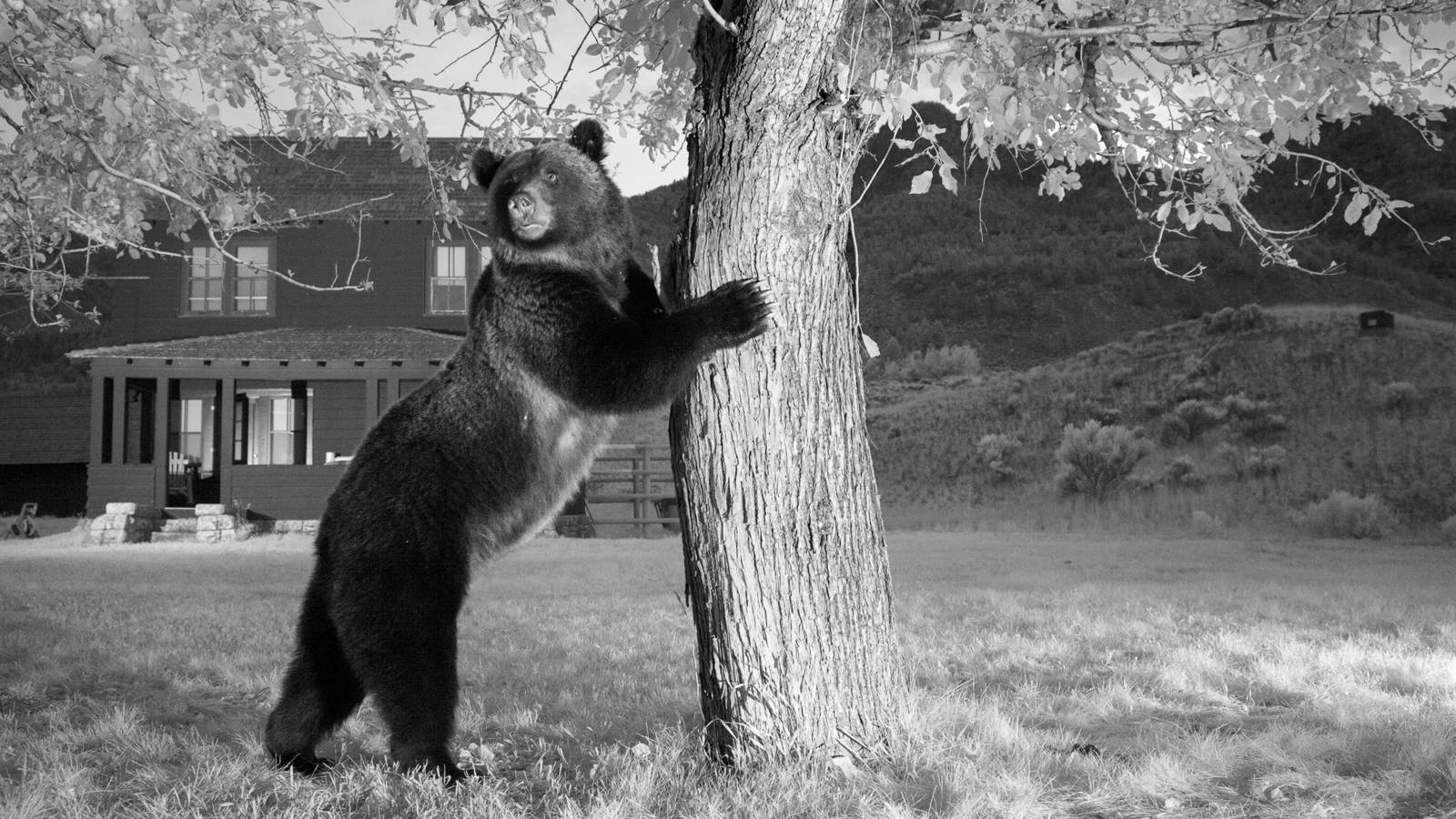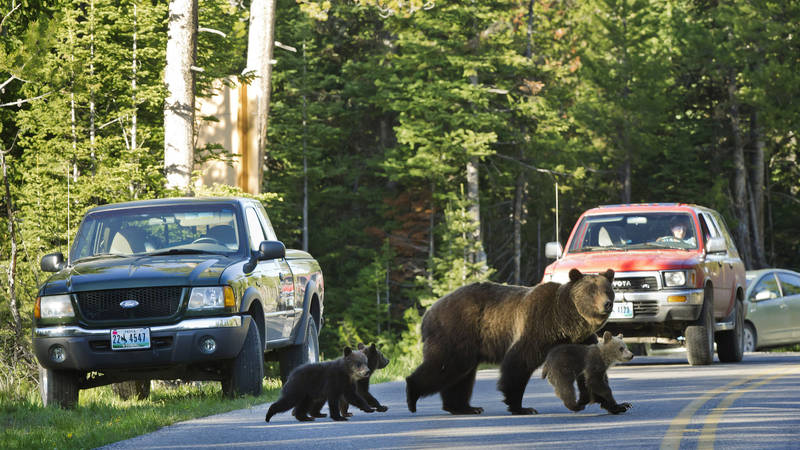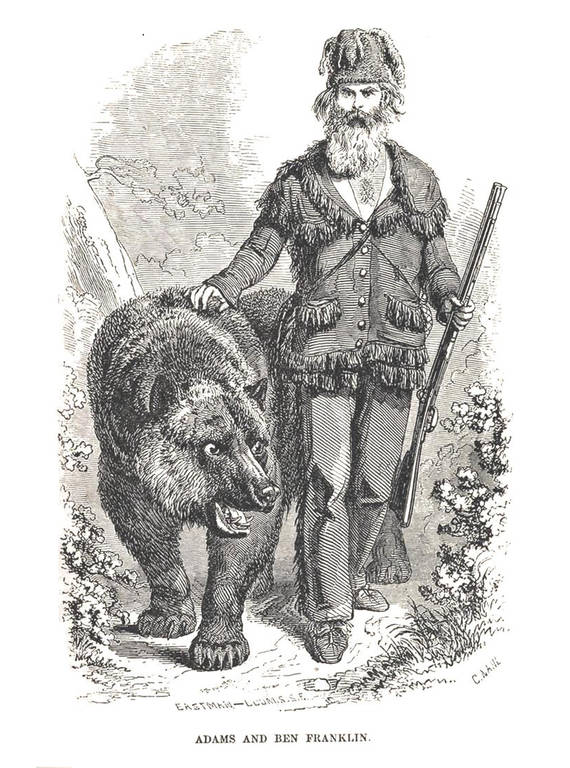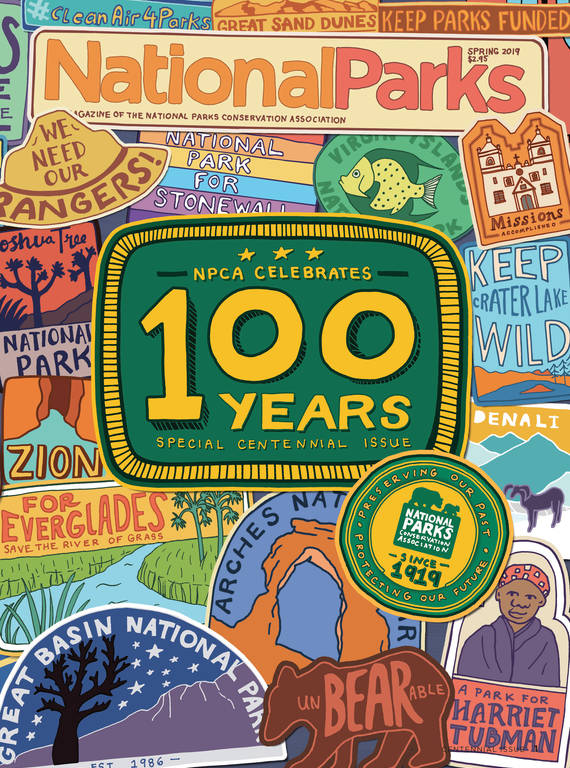Spring 2019
Fighting for the Grizzly
NPCA and others have worked for decades to protect Yellowstone’s grizzlies. Is the long-term recovery of the iconic species now in jeopardy?
On a mild August morning in the western Montana town of Missoula, dozens of people lined up outside the doors of a small federal courthouse. Some held a cloth banner that read “Respect Tribes. Respect Science. Protect Bears.” Others carried “Save the Yellowstone Grizzly” signs. For the activists, the urgency wasn’t exaggerated; many viewed the imminent court proceedings as a matter of life or death for the bears.
In 2017, the U.S. Fish and Wildlife Service declared Yellowstone-area grizzlies recovered and removed them from the list of threatened species. Wyoming and Idaho quickly moved to organize the first grizzly hunts to take place in the contiguous United States in decades. A coalition of conservation organizations — including NPCA — and Native American tribes disagreed that the bears were fully recovered. The groups sued the government over the delisting, arguing that it would put the Yellowstone grizzlies at risk and make it harder for them to eventually connect with the grizzly population in and around Glacier National Park. Now the judge inside the brick courthouse was to rule on whether the American West’s iconic species still needed federal protection. More urgently, Judge Dana Christensen also was to decide whether the grizzly hunts could move forward just two days later.
As soon as the doors opened, the crowd rushed in and quickly packed the courtroom. Those who didn’t make the cut filled a nearby atrium set up with a TV screen so they could follow the court proceedings. Sharon Mader, NPCA’s Grand Teton senior program manager, was one of the lucky ones who snagged a seat inside the courtroom. She and her colleagues felt they had a strong case, but she was nervous nonetheless.
“This is the only time that I have literally prayed to God during a court hearing for the right outcome,” she said.
Both sides presented their cases. Tim Preso, the Earthjustice attorney who represented NPCA and its partners, made a compelling case against the delisting and adroitly rebutted the federal lawyers’ attempts to undermine his arguments. After hearing that Christensen would not rule that day, Preso told the judge the plaintiffs would file a temporary restraining order to stop the hunts. Mader said she was impressed with his performance. “I started to feel much more comfortable,” she said.
Late in the afternoon, the judge confirmed Mader’s hunch. He indicated he needed more time to properly evaluate whether the government’s decision to delist the grizzlies of the Greater Yellowstone Ecosystem was warranted and placed the hunt temporarily on hold. It was a qualified victory, but grizzly advocates exhaled a collective sigh of relief.
For many, grizzlies are a symbol of the wildness that was. Perhaps as many as 50,000 grizzlies roamed the Western United States two centuries ago, occupying virtually every ecological niche, from the Pacific Coast to the Rockies and the Great Plains. These days, an estimated 1,400 to 1,700 grizzlies live in the Lower 48. Of those, about 700 grizzly bears inhabit the public and private lands in and around Yellowstone and Grand Teton National Parks, according to the Interagency Grizzly Bear Study Team, a group of government scientists and local Native American tribe members that monitors grizzlies in the Yellowstone region.

Before the arrival of European settlers, the grizzlies’ range in the West was largely continuous, but now Yellowstone’s bears are isolated from those in northern Montana (and Canada) — the Lower 48’s only other significant grizzly population. Together, these two populations occupy just a tiny fraction of the grizzly’s historical range. The isolation of a population can lead to low genetic diversity, which in turn can result in a higher susceptibility to disease and a reduced ability to produce healthy offspring. Grizzlies have one of the lowest reproductive rates among North America’s mammals, so any decrease would pose a threat to the population’s survival. Many grizzly experts hope the two main populations will eventually overlap and provide Yellowstone grizzlies with a healthy dose of new genes.

Cars stop in Grand Teton National Park to let a female grizzly and her cubs cross the road.
© THOMAS D. MANGELSEN/AP PHOTOOnly 70 miles separate the two populations, but grizzlies face an increased mortality risk on a patchwork of federal, state and private land crisscrossed by highways. To counter that risk, a robust Yellowstone population is critical for the species to establish itself along that corridor, said David Mattson, a former member of the Interagency Grizzly Bear Study Team who has researched Yellowstone’s grizzlies for decades.
A Food Quandary
Improving the grizzlies’ ability to move back and forth between the Yellowstone and Glacier ecosystems would also make the species more resilient to another growing threat. Already, climate change has drastically altered the diet of Yellowstone’s grizzly bears. Grizzlies in the region eat a wide variety of plants but have historically gotten most of their proteins from whitebark pine nuts, army cutworm moths, elk or bison meat, and Yellowstone cutthroat trout. Depending on their territories, individual bears rely on certain sources of proteins more than others, but some of these foods have become scarcer overall.
Cutthroat trout have suffered greatly from predation by larger, invasive species such as lake trout, which were released illegally into Yellowstone Lake more than two decades ago. (Lake trout, which live deeper in the lake, are not a viable food source for grizzlies.) Warming summer temperatures also reduce suitable habitat for the native trout and can increase the species’ vulnerability to disease. Due to the decline of the cutthroat population, the amount of trout consumed by grizzlies decreased by 70 percent in a decade. The region’s army cutworm moths are similarly in trouble. Each summer, the insects fly from farmland in the Great Plains to the Yellowstone area to feed on the nectar of flowers in the alpine meadows there. Grizzlies eat as many as 40,000 of the insects in a single day. As the climate warms, however, the meadows will slowly move up the slope until there is no more slope to climb. “That environment is going to go away,” Mattson said. Within a century, he predicts both meadows and moths will “go off the top of the mountain.”
Climate change also has wreaked havoc on Yellowstone’s stands of whitebark pine. The pine’s main pest is the mountain pine beetle, which bores holes into the tree to lay eggs, setting off a chain reaction that eventually kills the host tree. The insects are usually kept in check by cold winters, but warmer temperatures in recent years have led to a widespread beetle infestation.
NO TO BAITING BEARS
The bears’ omnivorous diet and adaptability have allowed them to compensate for the loss of pine nuts to some extent, and research suggests that the bears have been able to maintain their body weight and reproductive rates in part by consuming more meat. But each food source comes with a certain hazard level for the bears, Mattson said. Whitebark pine nuts are very safe to obtain because the pine forests tend to be located away from humans and often lie inside park boundaries. Some meat sources, such as elk calves or the carcasses of bison killed by wolves, are also relatively safe, but if hungry bears seek out livestock or gut piles left by elk hunters, the risk of conflict with humans increases dramatically.
Grizzlies in the Yellowstone region have been expanding their territories, pushing ever farther into areas with higher human occupation. Scientists on the Interagency Grizzly Bear Study Team believe the main reason for the dispersal is that the bears are too numerous in portions of the ecosystem and are colonizing new areas. Others think the expanding range of the Yellowstone grizzlies is motivated in part by the bears’ quest for meat. Over the past 16 years, grizzly deaths in accidental encounters with elk hunters increased on average by 5 percent per year. Over the same period, the number of grizzlies euthanized following livestock predation grew by an average 17 percent per year.
The grizzlies of the Greater Yellowstone Ecosystem are among the world’s most studied bears, yet research into climate change’s deleterious effects on grizzlies is relatively new. For Bart Melton, NPCA’s director of wildlife programs, that’s another reason Yellowstone grizzlies still belong on the endangered species list. “We need to proceed very cautiously,” he said. “The climate is clearly changing, and the impacts of climate change will accelerate exponentially. What that means on the ground for Yellowstone’s grizzlies in the years ahead is a relative unknown.”
Killing Bears — and Riding Them
Historically, many Native American tribes saw grizzlies as their ancestors or relatives, and many still revere the animals. (Recently, more than 200 U.S. and Canadian tribes signed a treaty to protect the species.) The pioneers who settled the West a couple centuries ago, on the other hand, felt no such kinship with the great bears. Fur traders hunted the grizzlies for their pelts, and cattlemen who moved into grizzly habitat saw the bears as a threat to be eradicated. Traps, poison and hired killers became the tools of a vast predator control campaign sanctioned by the states and the federal government.
Some of the men who exterminated grizzlies became legendary figures. Ben Lilly, who once served as a guide to President Theodore Roosevelt on a black bear hunt in Louisiana, reportedly killed hundreds of bears, many of them grizzlies, including several dispatched with his trusted Bowie knife. Thousands of grizzlies died in the campaign.

John “Grizzly” Adams, a hunter turned grizzly tamer.
© HUTCHINGS’ ILLUSTRATED CALIFORNIA MAGAZINEOne by one, states lost their grizzlies. Texas’ last grizzly was killed in 1900, Utah’s in 1923, and the last credible sighting of a California grizzly — other than on the state flag — occurred in 1924.
As grizzlies disappeared from much of the Western landscape, they garnered more interest from the general public. In the 1850s, John “Grizzly” Adams, a hunter turned grizzly tamer, was able to train several young grizzlies to follow him around and carry his pack. One, Lady Washington, even let him ride on her back at times. Grizzly Adams showed his bears in San Francisco and New York City where crowds of urbanites got their first look at the West’s apex predators.
Grizzly hunting was outlawed in Yellowstone National Park in 1886, and just a few years later, grizzlies began feeding at garbage piles behind the park’s hotels. Rather than discourage the bears, hotel managers set up “lunch counters” for them and constructed bleachers where hundreds of visitors sat to take in the “bear shows.”
A New Population Low
By the 1940s, attitudes about wildlife management had evolved. Several garbage dumps in Yellowstone remained open, but all public-viewing areas had closed, and sanctioned bear feeding had stopped. Major conservationists such as Aldo Leopold raised the public’s consciousness about the important ecological role of the grizzly and the rapid decline of the animal’s population. “There seems to be a tacit assumption that if grizzlies survive in Canada and Alaska, that is good enough. It is not good enough for me,” he wrote in “A Sand County Almanac,” his seminal book published in 1949. (To date, few studies have sought to quantify the bears’ impact on the ecosystem, but it is likely significant. As top predators, grizzlies help keep ungulate populations in check. They disperse seeds through their droppings, and research shows that they can increase the concentration of nutrients in the soil when they dig for bulbs to eat.)
Extensive research by brothers John and Frank Craighead during the 1960s showed that garbage remained the most important food for Yellowstone grizzlies. After two young women were killed by garbage-conditioned grizzlies in Glacier National Park during a single night in August 1967, the Park Service took a hard look at its bear management practices, and within three years, Yellowstone managers had closed all the park’s dumps. The hope was that the bears would turn to natural food sources, but many reacted by seeking out other sources of garbage in campgrounds and inhabited areas outside the park. Conflicts with people increased, and many more bears were killed or moved to zoos after the dump closures than in preceding years.
In 1974, both Wyoming and Montana scheduled their regular fall season grizzly hunts. That year, the Craighead brothers estimated the total grizzly population of the Greater Yellowstone Ecosystem at a historic low of 136. “That really kicked things off,” said Stephen Herrero, a professor emeritus at the University of Calgary and an expert in bear management. “There we had a national icon that was in serious danger of being lost.” NPCA and other conservation organizations spoke out against the hunts and called for the grizzlies to be protected under the Endangered Species Act passed just one year earlier. The hunts went forward, but in 1975 the Fish and Wildlife Service listed the grizzly bear as a threatened species in the Lower 48 and placed a moratorium on grizzly hunting in the Yellowstone region.
A Recovering Population
Thanks to the law’s protection and improved bear management, Yellowstone’s grizzly population started a long road toward recovery. After removing problem bears and chasing away those that got too close to people, park managers realized they should concentrate on changing human behavior instead. They embarked on campaigns to educate visitors on the need to carry bear spray on trails, properly store their food and keep their distance from the bears. Despite record visitation numbers in Yellowstone and Grand Teton and a rebounding bear population, the risk of being attacked by a grizzly is now minimal. Human behavior has improved, but the grizzlies have done their part, too, by learning to steer clear of humans. “I credit the bears,” said Frank T. van Manen, a wildlife biologist who leads the Interagency Grizzly Bear Study Team. “There are a lot of encounters that didn’t happen because the bears ran away.”
After three decades of restoration efforts, the Fish and Wildlife Service delisted the species in the Greater Yellowstone Ecosystem in 2007. Two years later, a judge in the Missoula federal court invalidated the decision, ruling that available science contradicted the agency’s interpretation that grizzlies could adjust to the impact of climate change on whitebark pine. Yellowstone grizzlies were back on the threatened species list.
Over the past decade, bears have expanded their territory and moved farther from the parks, which has made management trickier. In areas where grizzlies are appearing for the first time in decades, ranchers are not accustomed to disposing quickly of dead livestock or using electric fencing, elk hunters don’t always carry bear spray or remove carcasses promptly, and residents may not be willing or even know to buy bear-proof garbage cans or pick up fruit that’s fallen to the ground. In 2018, 65 grizzly deaths were recorded in the Yellowstone region — a 16 percent increase over the previous year’s toll. Of those documented deaths, at least 43 were caused by humans, including grizzlies that were euthanized after preying on livestock, bears that were killed in vehicle collisions and one that accidentally fell in fast-flowing cement.
UNFINISHED BEAR BUSINESS
Outreach and education are crucial to mitigate human-bear conflicts, said NPCA’s Stephanie Adams, but so is a genuine commitment from state and federal wildlife managers to provide the support and resources needed to prevent or reduce conflicts when grizzlies return to landscapes where they have been absent for decades. “We have to be willing to work with all stakeholders, even if they have different opinions, and we have to be willing to hear their concerns,” said Adams, NPCA’s associate director for the Northern Rockies.
After the Fish and Wildlife Service delisted Yellowstone grizzlies for a second time two years ago, Wyoming decided to issue 22 hunting licenses, and Idaho issued one. Grizzly enthusiasts worried that bears that call Yellowstone and Grand Teton National Parks home for part of the year would be vulnerable when they moved beyond park borders. There was particular concern about Grand Teton’s bears. Grizzlies there are generally more visible than those at Yellowstone, and some have achieved international celebrity. The park is relatively narrow, so bears easily move in and out. Unlike in Yellowstone, limited elk hunts are legal inside Grand Teton, so some grizzlies there have developed a taste for the elk guts hunters leave behind. While grizzlies can safely feed on elk carcasses in the park, doing so beyond park boundaries would be very risky if the hunt were to proceed. Thomas Mangelsen, a photographer who has spent more than a decade documenting the life of a Jackson Hole grizzly, said in an interview with a local publication before the court hearing that because Grand Teton grizzlies didn’t view hunters as threats, they would make easy targets. “It will be like shooting your sofa,” he said.
Melton, NPCA’s wildlife director, said his team’s main consideration when deciding whether to sue the federal government was the potential impact of taking 23 grizzlies out of a population that has suffered large losses recently and faces an uncertain future. “We said, ‘Let’s just look at: Could the population bear the brunt of this?’” he said. “We found our answer was no.”
Connect, Connect, Connect
On Sept. 24, more than three weeks after the hearing, Judge Christensen finally issued his decision. Christensen ruled that the Fish and Wildlife Service’s analysis of the threats faced by Yellowstone’s grizzlies was “arbitrary and capricious” and did not justify delisting the species. What’s more, he specifically noted that the agency had failed to demonstrate that the isolation of Yellowstone’s grizzlies did not pose a threat to the long-term health of the population. NPCA and other plaintiffs had focused much of their arguments on the importance of connectivity, so the ruling felt like validation. “I was over the moon, really ecstatic,” Melton said.

National Parks
You can read this and other stories about history, nature, culture, art, conservation, travel, science and more in National Parks magazine. Your tax-deductible membership donation of $25 or more entitles…
See more ›The legal battle is likely not over, as the Fish and Wildlife Service filed a notice in December to appeal Christensen’s ruling. In the meantime, NPCA and its allies will continue to work to create the conditions for Yellowstone’s and Glacier’s bears to connect, breed and improve their genetic health.
Most parties agree that the grizzlies will eventually touch noses somewhere in Montana. The state conducted grizzly hunts until 1991 — it was the last state to drop the practice — but it did not follow Wyoming and Idaho in organizing hunts last year. Sarah Lundstrum, NPCA’s Glacier program manager, sees that as a sign that Montanans’ attitudes toward grizzlies are slowly changing. Still, she said it will take a lot of work to make all people in their paths at ease with the bears’ return.
“I think bears are going to connect before we figure it out,” she said.
Learn more about other animals NPCA has worked to protect..
About the author
-
 Nicolas Brulliard Senior Editor
Nicolas Brulliard Senior EditorNicolas is a journalist and former geologist who joined NPCA in November 2015. He serves as senior editor of National Parks magazine.



